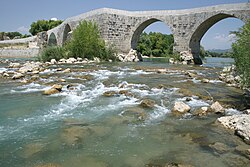Battle of Eurymedon
| Battle of the Eurymedon | |||||||
|---|---|---|---|---|---|---|---|
| Part of the Wars of the Delian League | |||||||
 The Eurymedon River, near Aspendos |
|||||||
|
|||||||
| Belligerents | |||||||
| Delian League | Achaemenid Empire | ||||||
| Commanders and leaders | |||||||
| Cimon |
Tithraustes, Pherendatis |
||||||
| Strength | |||||||
| 200 ships | 200–350 ships | ||||||
| Casualties and losses | |||||||
| Unknown | 200 ships captured and destroyed | ||||||
The Battle of the Eurymedon was a double battle, taking place both on water and land, between the Delian League of Athens and her Allies, and the Persian Empire of Xerxes I. It took place in either 469 or 466 BC, in the vicinity of the mouth of the Eurymedon River (now the Köprüçay) in Pamphylia, Asia Minor. It forms part of the Wars of the Delian League, itself part of the larger Greco-Persian Wars.
The Delian League had been formed between Athens and many of the city-states of the Aegean to continue the war with Persia, which had begun with the first and second Persian invasions of Greece (492–490 and 480–479 BC, respectively). In the aftermath of the Battles of Plataea and Mycale, which had ended the second invasion, the Greek Allies had taken the offensive, besieging the cities of Sestos and Byzantium. The Delian League then took over responsibility for the war, and continued to attack Persian bases in the Aegean throughout the next decade.
In either 469 or 466 BC, the Persians began assembling a large army and navy for a major offensive against the Greeks. Gathering near the Eurymedon, it is possible that the expedition aimed to move up the coast of Asia Minor, capturing each city in turn. This would bring the Asiatic Greek regions back under Persian control, and give the Persians naval bases from which to launch further expeditions into the Aegean. Hearing of the Persian preparations, the Athenian general Cimon took 200 triremes and sailed to Phaselis in Pamphylia, which eventually agreed to join the Delian League. This effectively blocked the Persian strategy at its first objective.
...
Wikipedia
